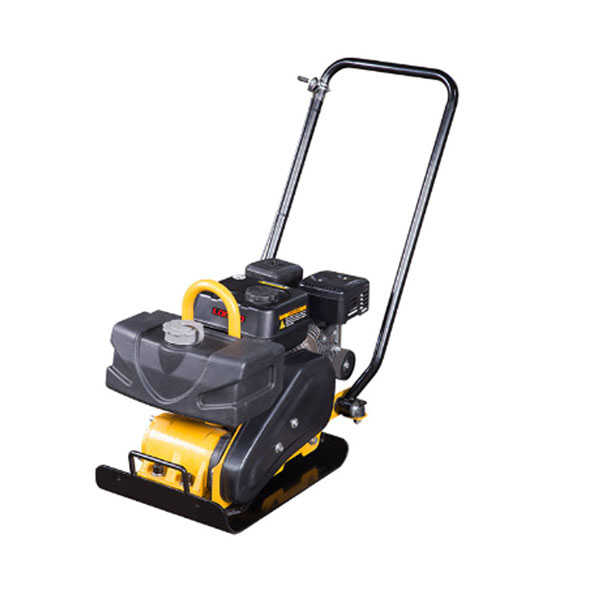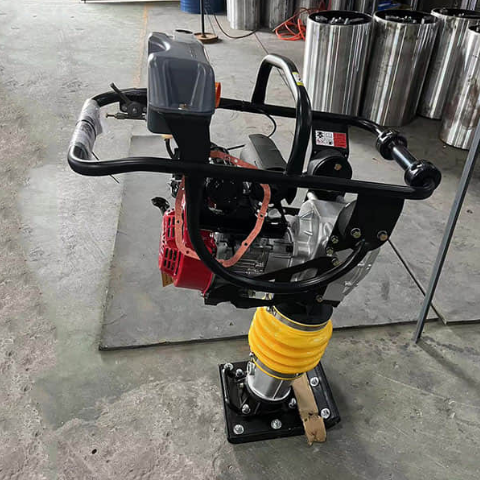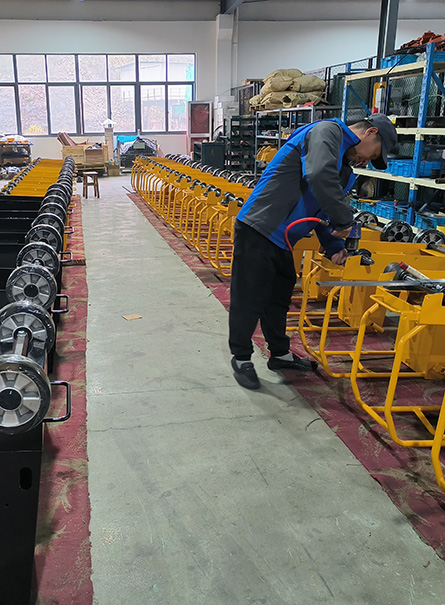Compaction is a crucial process in construction, involving increasing soil density, reorganizing soil particles, and reducing voids. This results in soil with a higher unit weight and enhanced bearing capacity, which is essential since soil in its natural state is often weakly connected. Effective compaction is key to preventing soil settlement that can lead to structural damage, bending forces, or even tilting of structures over time. Ensuring solid compaction is vital for the stability and longevity of any construction project.
These compactors utilize repeated impacts to level and densify the soil. The method is effective in increasing the dry density of the soil, making it ideal for certain types of terrain and projects.
Plate compactors feature a heavy, flat plate that sits on the ground when the machine is off. Powered by gasoline or diesel motors, these compactors move the plate up and down to compress the soil. They come in various designs and attachments, but their primary function remains consistent across models.

In this comparison, we will delve into the specifics of both jumping jack and plate compactors to help you determine the best equipment for your specific construction needs. Understanding the differences and applications of each will guide you in making an informed decision for your project.
Jumping Jack vs Plate Compactor: Key Differences
Jumping Jack Compactor:
A jumping jack compactor, also known as a rammer or jumping jack tamper, is designed to compact soil by delivering a series of impacts. This process effectively levels uneven surfaces and increases the soil's dry density by removing air and water.
- Suitability and Advantages:
Best for cohesive soils with about 13% moisture content.
Ideal for hard-to-reach areas like trenches and ditches due to its small size.
Recent models are easily maneuverable by one operator.
Its direct compaction ability makes it perfect for confined spaces, contributing to faster project completion and efficiency in smaller areas.
- Limitations:
Jumping jacks may lack the necessary force for heavy soils or rocky areas.
Less efficient in larger spaces compared to plate compactors.
A plate compactor works with a heavy plate at the bottom of the machine that rapidly moves up and down during operation. This action, combined with the plate's weight and impact, firmly compacts the soil beneath.
- Suitability and Advantages:
Most effective on granular soils with high sand or gravel content.
Moistening the soil beforehand can enhance performance.
Generally, 2-4 passes are sufficient for optimal compaction, though specific guidance can be sought from the Horizont.
Ensures a durable and stable project foundation, reducing the risk of future movement and settling. It also creates a smoother and more even surface for various uses.
- Limitations:
The heavy weight of the machine, while necessary for compaction, can be a disadvantage. It can be challenging to transport, usually requiring two people.
While operational, the vibrations ease movement, but the machine is less helpful when still.
Understanding the main benefits and drawbacks of jumping jack and plate compactors will guide you in selecting the right equipment for your specific soil compaction needs.
Comparing Jumping Jack Compactors and Plate Compactors
When choosing between a jumping jack compactor and a plate compactor, several key differences should be considered:
- Compaction Force and Depth:
Plate Compactors: Can achieve a maximum compaction depth of up to 18 inches, offering more power and deeper soil penetration.
Jumping Jacks: Typically have a compaction depth limit of around 8 inches, restricted by their design.
- Maneuverability:
Jumping Jacks: Their lighter weight and smaller size allow for better maneuverability, especially in narrow or confined spaces.
Plate Compactors: While larger, they provide a higher compaction rate, making them more suitable for larger-scale jobs.
- Cost:
Plate Compactors: Generally more expensive due to their larger size and enhanced compaction abilities.
Jumping Jack Compactors: Often less costly, though prices vary depending on the specific model and features.
The choice between these two types of compactors will depend on the specific requirements of your project, including the size of the area, the type of soil, and budget constraints.
Weight and Energy Consumption Comparison:Assessment of Jumping Jack vs Plate Compactor
In the realm of ground compaction mechanisms, the choice between a Jumping Jack and a plate compactor hinges significantly on their distinct mass and power utilization characteristics. This contrast is crucial when pinpointing the optimal apparatus for specific construction tasks.
Diving into specifics, the Jumping Jack, alternatively known as a rammer or tamper, possesses a weight spectrum of 18-30 kg. It achieves a compaction depth of approximately 25 cm and excels in compacting granular substrates, including silt, silty sand, gravelly sand, and moderately dense fine-grained soil. Conversely, plate compactors, with their weight ranging between 46-98 kg depending on their design and model, demonstrate versatility across various soil types, particularly shining in cohesive materials owing to their expansive foot print area.
Addressing the aspect of energy consumption, Jumping Jacks stand out for their higher fuel efficiency, primarily due to their reduced operational mass. They are powered by less energy-intensive air-cooled petrol engines. In contrast, plate compactors employ forced vibration motors with a mechanical clutch system, necessitating greater power input and consequently, increased fuel consumption.
Summarizing, while Jumping Jacks boast a lighter framework and reduced fuel demands, plate compactors are more apt for tasks involving cohesive soils or necessitating deeper compaction depths. Having explored the disparities in weight and energy usage between Jumping Jacks and plate compactors, a subsequent analysis will delve into their comparative suitability for construction and road projects, integrating "jumping jack vs plate compactor" into the broader context of construction efficacy.
Jumping Jack and Plate Compactor: Construction and Road Projects Impact
In the sphere of construction and road projects, the utilization of either a jumping jack compactor or a plate compactor is a matter of specific project requirements. The jumping jack compactor stands out in confined or restricted spaces due to its smaller footprint. This attribute renders it highly effective for tasks in cramped areas, particularly for compacting soil or asphalt in slender trenches, or executing pneumatic or vibratory operations over extensive flat regions.
On the flip side, the plate compactor comes into its own when a more robust compaction force is needed, especially for asphalt and denser materials. Its high impact force and substantial contact surface area are instrumental in bolstering the solidity of packed earth. This makes it particularly advantageous for expansive projects with lengthy stretches of flat terrain.
Each apparatus presents a unique blend of benefits and limitations. The jumping jack compactor, while adept at navigating tight spaces, sacrifices some power due to its lighter build. In contrast, the plate compactor, although limited in agility, compensates with its potent impact forces, a byproduct of its heftier design.
Deciding between a jumping jack compactor and a plate compactor hinges on the specificities of the construction endeavor at hand. This choice requires a careful evaluation of each machine's strengths and limitations, ensuring alignment with the project's demands.
The forthcoming section will delve into guiding principles for selecting the appropriate machine. We'll examine each machine's characteristics, benefits, and other critical factors such as cost, safety considerations, and operational prerequisites. This will aid in determining the most suitable option for your specific project.
Choosing the Right Compaction Equipment
Ultimately, the choice between a jumping jack and a plate compactor should be guided by the project's specific requirements. Factors like the material type, the area size, and the desired compaction finish are critical in determining which tool is more appropriate for your job. Each compactor type has its strengths and ideal applications, so assessing these aspects will help you make an informed decision for your soil compaction needs.
People Also Ask
What are the advantages of a jumping jack compactor over a plate compactor?
A jumping jack compactor stands out with several distinct advantages compared to a plate compactor. Primarily, it showcases enhanced agility, facilitating smoother functioning in narrow or constrained areas. Furthermore, the jumping jack compactor is notably efficient in attaining peak soil compression, adept at performing both unidirectional and overlapping compaction techniques. An additional merit is its reduced tendency to falter or get mired in moist soil conditions, a notable improvement over plate compactors, ensuring more effective compaction results in such environments.



